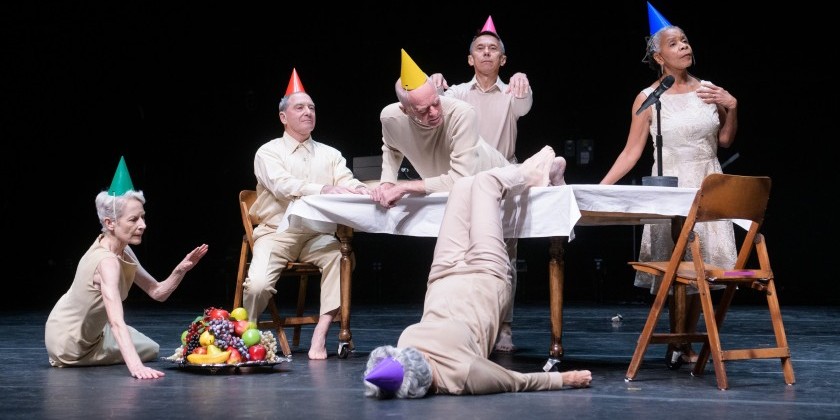The Dance Enthusiast Hits the Streets: New York City Center's Studio 5: Approaches to Mastering Choreography

Curated and Moderated by Tyler Angle with Daniel Applebaum, Austin Goodwin, Lauren King, and Taylor Stanley
January 27, 2020
Curated and moderated by New York City Ballet Principal, Tyler Angle
Dancers: Daniel Applebaum, Austin Goodwin, Lauren King, and Taylor Stanley
Pianist: Susan Walters
Tyler Angle, although physically impaired by a mild foot injury, ably hosted the first in a three-part series on mastering choreography. To illuminate this process, the New York City Ballet principal dancer solicited a crew of fellow company members – Lauren King, Daniel Applebaum, and it man, Taylor Stanley. As Artistic Director of the Nantucket Atheneum Dance Festival, Angle commissioned a premiere last year from the young contemporary choreographer Austin Goodwin and recruited him for this event to devise a phrase in real-time, which enabled us to witness dancers learning, integrating, and refining new movement.
This insight into the rehearsal process offered a rare glimpse of a dancer’s work – a daily practice of details serving the magical synthesis later revealed to a paying public. The inherent tediousness of this process permeated the lecture/demonstration, resulting in a somewhat wearisome viewing experience. Perhaps if Angle streamlined the proceedings by highlighting movement more and refining his examples, then my interest might have mounted. Most striking about this event was its escalation of my ongoing concerns: the challenge of preserving legacy and the urgent need to refurbish ballet’s elements of training.

King and Applebaum first teased us. They repeatedly surged onto the dance floor, divulging the myriad possible entrances before the meat of Balanchine’s Nutcracker pas de deux. Each time, our anticipation of the dancing to come was denied. Maybe this was Angle’s idea of foreplay.
The next snippet distilled one of Balanchine’s partnered turns in which a counterclockwise promenade abruptly transforms into a pirouette spinning to the right. Angle disclosed that some coaches stray from the original where the leg immediately converts from an attitude derrière to an attitude en avant due to the difficulty maintaining the flow of motion. Instead, some ballerinas now place their gesture leg in passé during the promenade to more easily achieve the desired uninterrupted swirl.
If this event included a question and answer session, I may have asked if Balanchine would have condoned this alteration implemented for convenience’s sake or if he would have coaxed his dancers to produce the intended quality without sacrificing the integrity of the leg line. It was unclear when this adaptation was introduced; I assume the answer is post-Balanchine. Wasn’t it Balanchine’s combination of steps and vernaculars, plunges off the vertical axis, and fiery speed that revolutionized an old art form and furnished ballerinas with expanded technical prowess? This promenade example may perhaps point to the inherent dilemma when a company loses its founder. Without the visionary at the helm, will those embodying the challenges seek the easier way?

These two moments were the only taste of ballet afforded. The bulk centered on the eclecticism demanded from today’s ballet performers. Stanley, humble when speaking yet commanding in motion, deftly executed phrases from works created on him by contemporary choreographers Andrea Miller and Kyle Abraham (Middle Length Poem and The Runaway, respectively). His upper spine, free from ballet’s invisible binding corset, articulated in all directions like an undulating cobra. King and Applebaum reenacted a passage from Goodwin’s Chorus & Cavalcade in which the utilization, rather than resistance, of weight proved imperative (and difficult to achieve). And the three, together, vulnerably learned a writhing, sunken tidbit choreographed on-the-spot by Goodwin. Accustomed to learning from visual examples, the dancers explained the challenges involved when working with contemporary choreographers who often mine for original material using verbal prompts.
Most concerning was the realization that these magnificent dancers so highly trained in their very specific ballet technique must now regularly speak in languages quite foreign. Years spent outwardly rotating the legs, defying gravity, pulling up through the spine, feigning regality, and maintaining balance and control fail to support current tasks to do the opposite – inwardly rotate the legs, embrace weight and effort, mobilize spines, present as authentic (replete with flaws, woes, and idiosyncrasies), and daringly disregard the vertical axis. Only someone such as Stanley – a body and soul so open, mutable, and coordinated – convincingly inhabits either style with ease. His type is few and far between.

As ballet launches into this new decade and beyond, pedagogues carrying the tradition forward should reconsider aspects of training. Why not bring features and tenets from other genres into ballet’s regimented system of exercises? What would a ballet class look like with an emphasis on movement of the torso, exercises in both rotated and parallel positions, and a play between pulled up and grounded? Four of the six examples Angle included required the dancers to move in ways entirely different, if not opposite, from their training.
The dancers’ struggle was apparent. Angle’s curatorial choice reflected ballet’s choreographic trajectory. Instead of our greatest performers feeling, in their words, “incompetent in the process,” and admitting, “I don’t yet have a grasp,” exposure to ballet’s evolving vocabulary could arm our physical poets with the tools needed to more effectively communicate with audiences.













